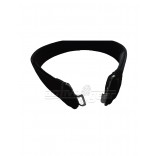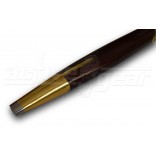Details
Queen's Royal Arms- Warrant Officer Class One Insignia
Regimental sergeants-major, who before the Boer War had worn four chevrons with a crown, were given in 1902 the badge of a single large crown on the lower arm, but adopted a small version of the Royal arms in its place in 1915 when they became warrant officers class I (WOI) as the warrant officer class extended. There was a requirement to introduce a suitable rank badge. And the decision was made to extend the use of the Royal Arms (Royal Coat of Arms of the United Kingdom) already in use with ‘Sergeant Majors’ in Foot Guards. The wearing of a smaller version of the badge below the elbow was in keeping with what was the practice when the Crown was the only badge of Warrant rank.
Warrant officers class one wear the Royal Arms on the lower sleeve, except for the regimental sergeant majors of Foot Guards Regiments who wear a larger version of the same coat of arms on the upper sleeve. The insignia of those holding the most senior WOI appointment of Conductor is the coat of arms surrounded by a wreath. There are also certain senior grades of warrant officer within the British Army, peculiar to the specialist branches, which ranked above regimental sergeants-major. These were the conductors of the Army Ordnance Corps and the first-class staff sergeants-major of the Army Service Corps and the Army Pay Corps. They also wore a large crown, surrounded by a wreath, on the lower arm, and in 1918 this was replaced by the Royal Arms within a wreath. The Royal Arms within a wreath is the badge of rank for a Conductor, the most senior of all WOI appointments, confined to the Royal Logistic Corps and held by fewer than twenty people as of 2004.
Regimental Quartermaster Sergeant
Regimental quartermaster-sergeants wore four chevrons on the lower sleeve, point upwards, with an eight pointed star above, but adopted the crown when they too became warrant officers class II in 1915. In their case, however, the crown was surrounded by a wreath. Regimental Quartermaster Sergeant (RQMS) is an appointment held by a senior Warrant Officer Class 2 in the British Army and Commonwealth countries. The RQMS is the senior assistant to the Quartermaster of a regiment or battalion and also usually functions as the deputy Regimental Sergeant Major. Some units have more than one RQMS. RQMS was a separate rank until 1915, when it became a Warrant Officer appointment with the creation of Warrant Officers Class II. From 1938 to 1947 all WOII ranks wore the crown in wreath rank now worn by Regimental Quartermaster Sergeants.
Warrant Officer Class Two
The pre-war infantry rank of Colour Sergeant had generally given way to the ranks of company sergeant-major and quartermaster-sergeant in 1914 when the four-company organisation was introduced. Both of these ranks, their squadron and battery equivalents, and staff-sergeants in other arms, wore three chevrons and a crown. In 1915 company, battery, squadron and troop sergeants-major became warrant officers class II (by Army Order 70) and thereafter wore a single large crown, without any chevrons, on each forearm. The type of crown used was the Tudor Crown also known as the King’s Crown or Imperial Crown; this crown was used not representing the British Monarch personally but also “The Crown” meaning the sovereign source of government authority. As such, it appeared on numerous official emblems in the United Kingdom, British Empire and Commonwealth. One such area was the military of these countries which used the crown in many ways such as the rank for warrant officer class II and Major. The St. Edwards Crown replaced the Tudor Crown and so the military follow with the change as well as this crown is the present version used to represent the ranks and other official emblems of the forces in the Commonwealth.Note the designation of Warrant officer classes was in Roman rather than Arabic numerals until the latter half of the 20th century.
Additional Information
| size | N/A |
|---|
You may also be interested in the following product(s)
-

Courlene Belt
$19.99 -

Pace Stick
$189.99





